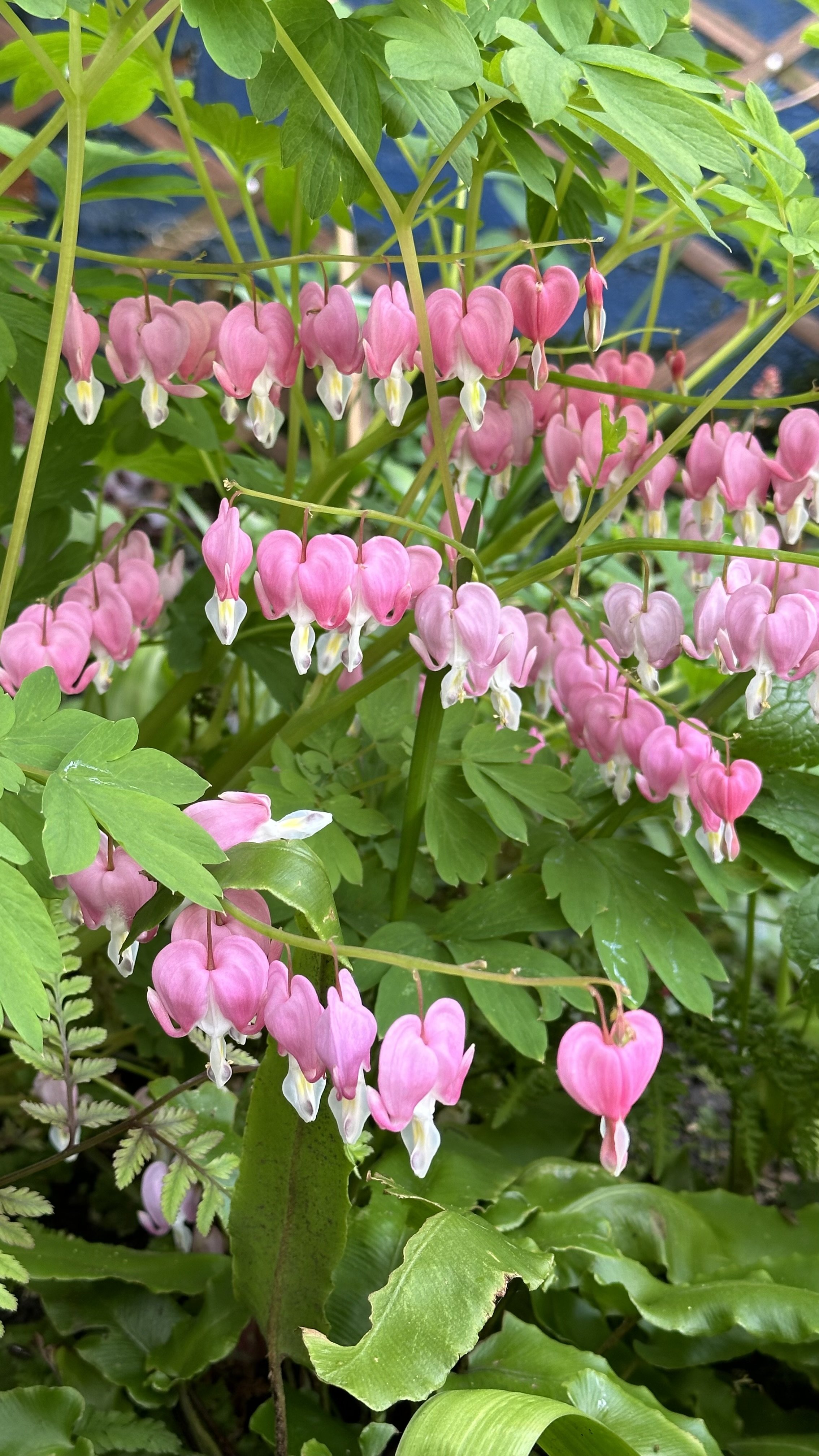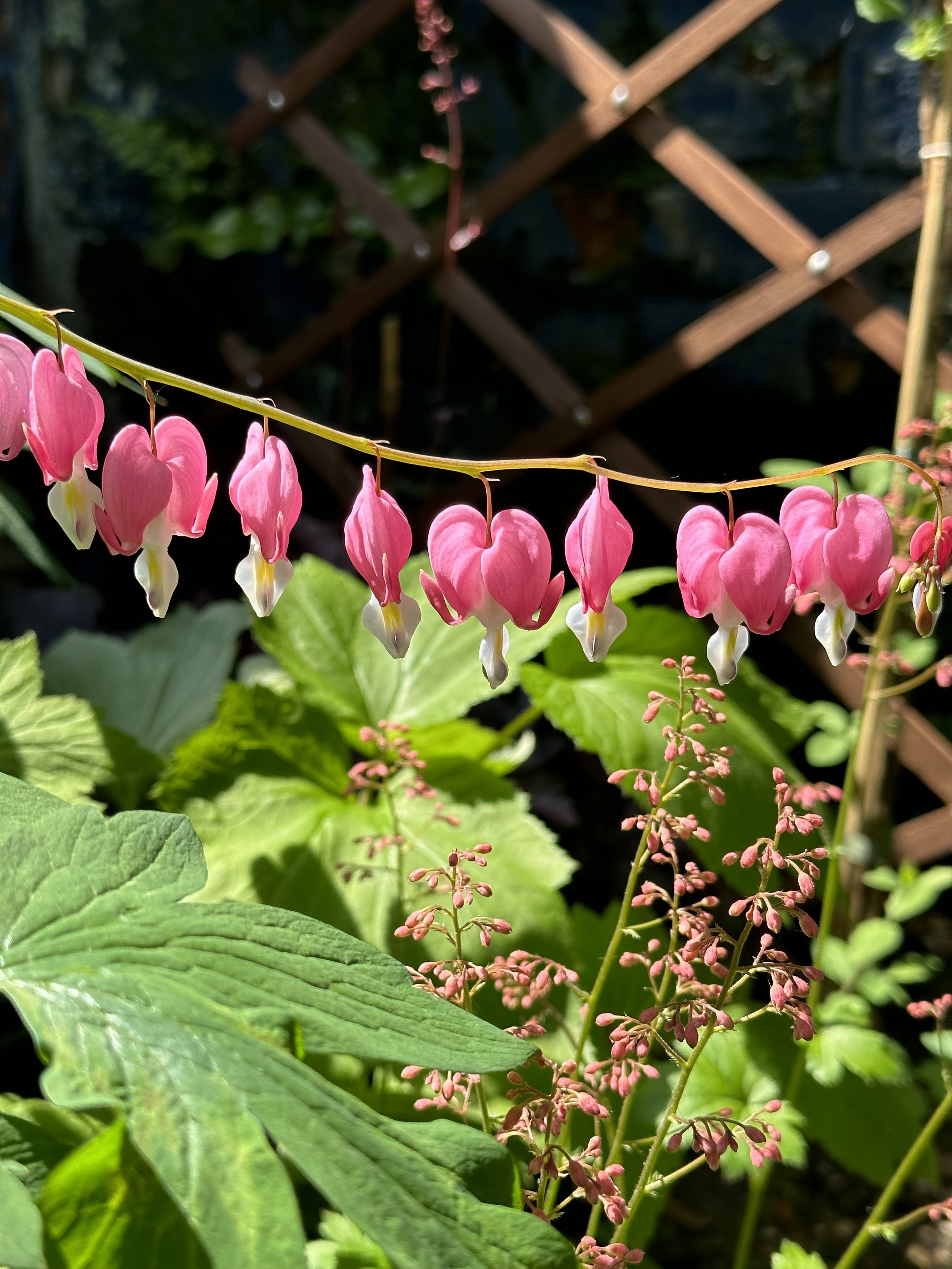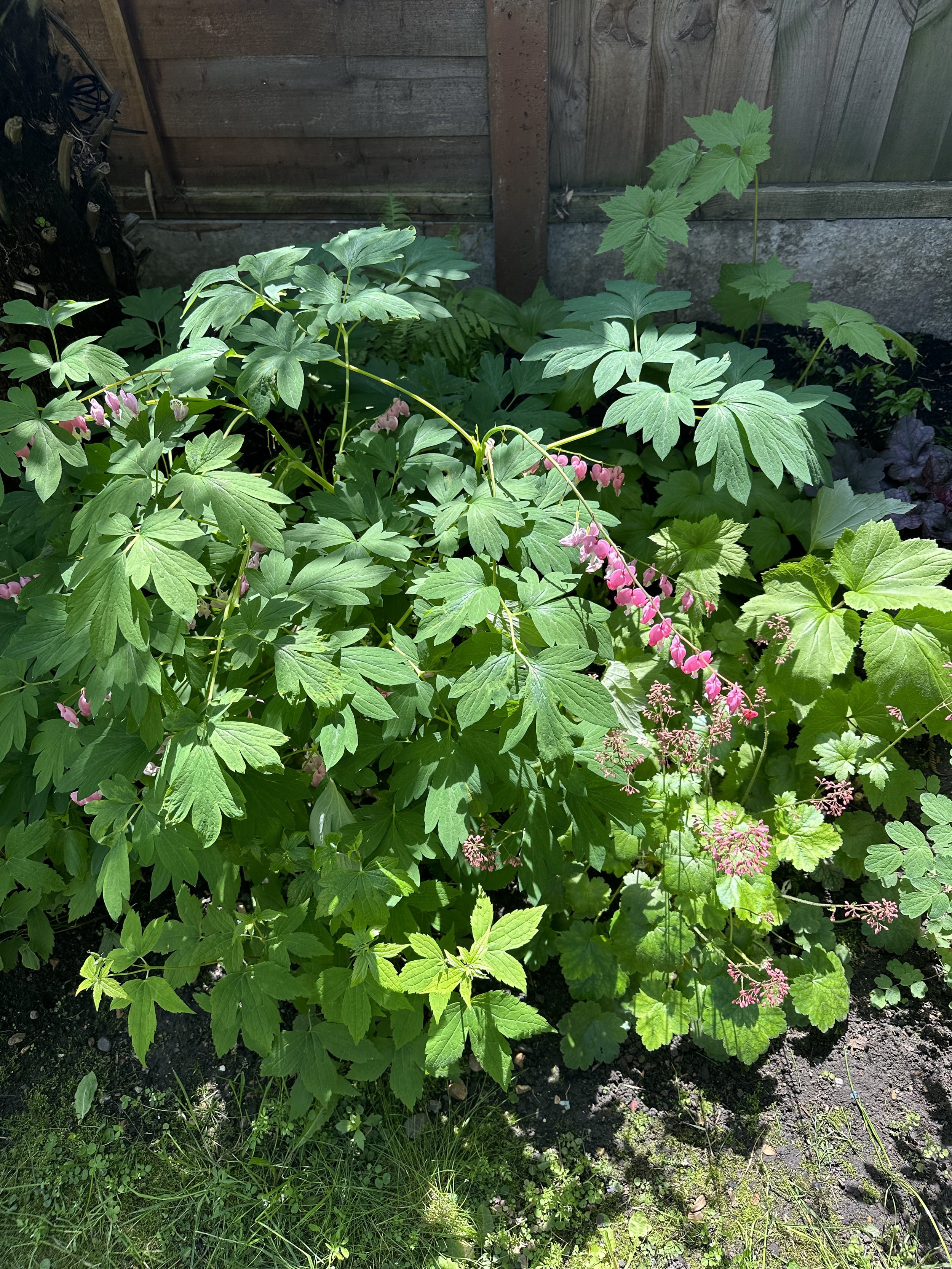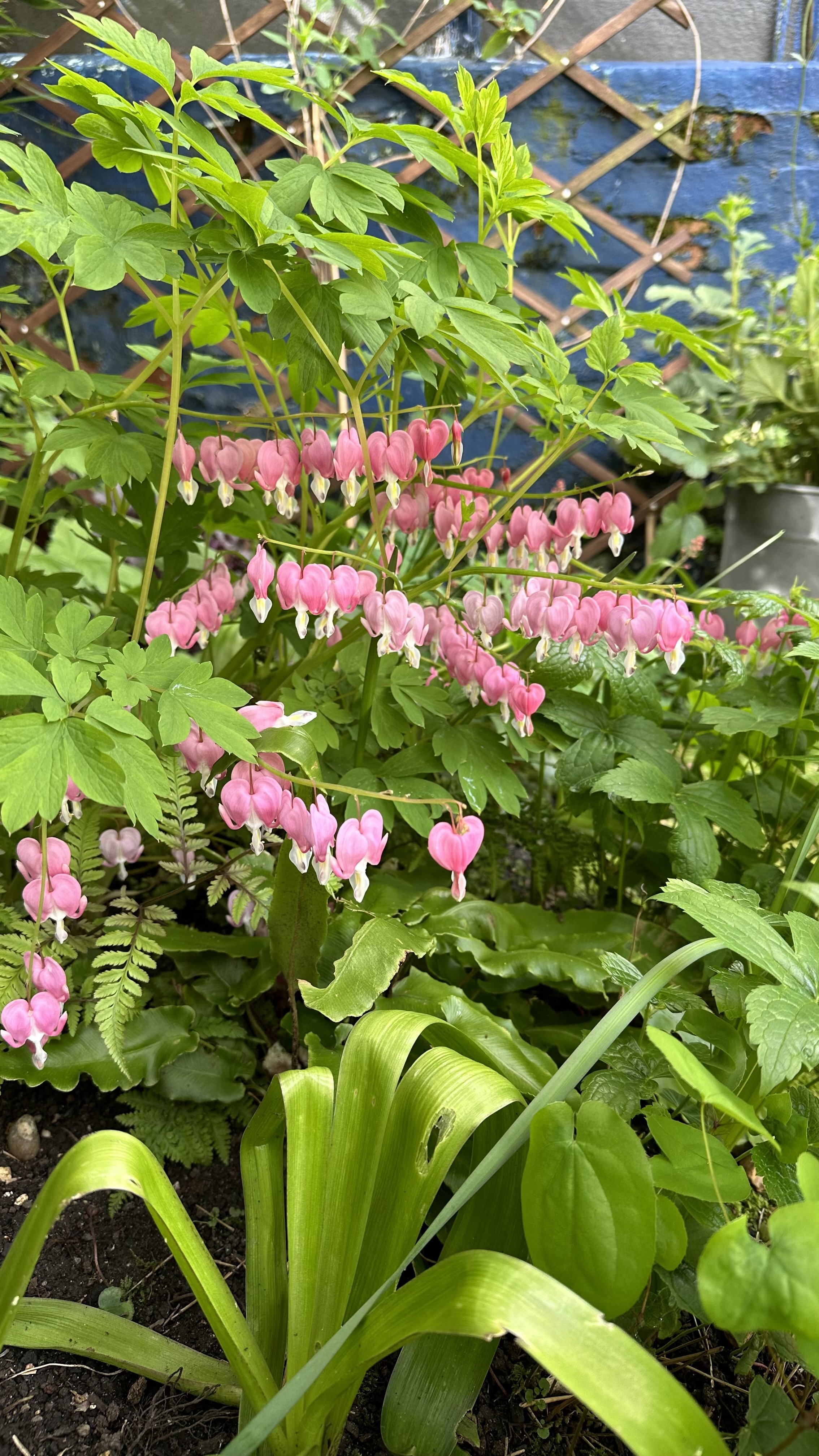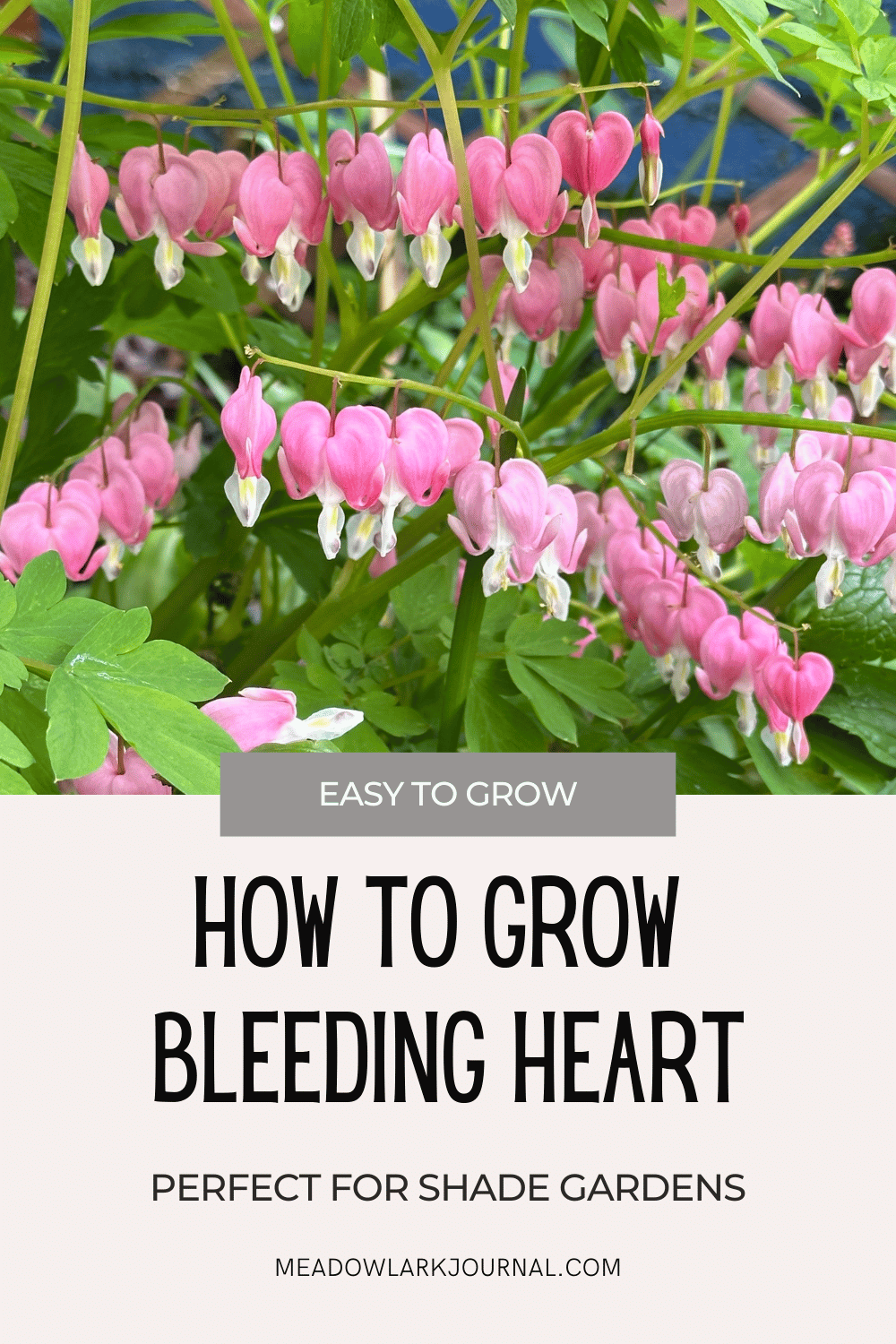How to Grow Bleeding Heart
This website is reader-supported - thank you! This post may contain affiliate links. As an Amazon Associate, I earn from qualifying purchases at no extra cost to you.
There’s something truly magical about a bleeding heart plant in bloom.
The delicate, heart-shaped flowers hanging from their arching stems seem almost too perfect to be real.
I remember the first time I saw one in full bloom—it's one of those plants that instantly captures your attention and makes you feel like you've stumbled upon a little secret of nature.
If you’re here, chances are you’ve fallen for these beautiful plants too, and you’re wondering how to grow them in your own garden.
Luckily, bleeding hearts are relatively easy to care for and do really well in shady gardens.
Here I’ll walk you through everything you need to know about growing, caring for, and even propagating bleeding heart plants, so you can enjoy their beauty for years to come.
For more shade garden ideas, check out my guides:
One of my favorite plants in the garden. My bleeding heart plant in full bloom in spring, something I look forward to every year.
Bleeding Heart Plants 101
Bleeding hearts are known scientifically as Lamprocapnos spectabilis, formerly Dicentra spectabilis.
Whether you call them bleeding hearts or heart flowers, they have a way of stealing the show with their unique, pink blossoms that look like tiny, bleeding hearts.
But what really makes these plants special isn't just their beauty—it’s how easy they are to care for, once you understand what they need.
Bleeding hearts are perennials, which means they come back year after year.
That makes them a great addition to your garden, especially if you’re looking for something that’ll brighten up a shady spot each spring.
They thrive in cooler, shaded areas, making them perfect for those parts of your garden that don’t get much direct sun.
One thing I learned early on is that bleeding heart plants like to stay cool, and they love rich, moist soil that drains well.
If you’re planting them, you want to make sure they’re not sitting in soggy soil, but at the same time, they don’t like to dry out completely.
Finding that balance is key to keeping these plants happy.
And, if you’re patient, you’ll be rewarded with lush green foliage and those unforgettable pink flowers each spring.
For more shady garden inspiration, check out my guides:
My bleeding heart loves the shadiest corner of my garden amongst the ferns.
Choosing the Right Spot for Bleeding Heart Plants
Trust me, after a little trial and error, I learned that these plants have a very specific idea of where they’re happiest.
Bleeding hearts are a little picky when it comes to sunlight, so it’s important to find just the right balance.
These plants love a shady environment.
So, if you’ve got a cool, slightly shaded corner of your garden that gets only a little morning sunlight, you’re in luck!
That's exactly the kind of spot that will make your bleeding heart plant feel right at home.
Full shade is their favorite, and they'll bloom best when they aren't exposed to the harsh midday sun.
That being said, if you’re in a place with particularly hot summers, it’s a good idea to avoid planting them in full sun—especially in the afternoon, when it’s at its hottest.
Bleeding hearts can get a bit stressed out if they get too much heat, and you’ll likely see the leaves start to wilt.
But on the flip side, a little bit of morning sun is perfectly fine and can even help them bloom beautifully.
It’s all about moderation!
Now, if you’re lucky enough to have a space with dappled light—where the sun filters through the leaves of taller trees or other plants—that’s another prime location.
I planted mine under a tree fern, and it has done wonderfully there, enjoying just a bit of light while being sheltered from the direct sun.
So, when choosing where to plant your bleeding heart, think about shade.
The right spot will help them bloom their best and keep that lush foliage looking fresh and healthy all season long.
For more shade garden ideas, check out my guides:
The Best Wildflowers for Shade
My bleeding heart 3 years ago during its first bloom.
My bleeding heart now, as you can see it can start to take up space over time.
How to Plant Bleeding Heart
Planting your bleeding heart is a pretty straightforward task, but I’ve learned that giving it a little extra attention at the start can really pay off down the line.
Once you’ve found that perfect spot in your garden (you know, the one with the right amount of shade), you’re ready to dig in!
I always find planting a new plant to be an exciting moment—it’s like a little promise of future blooms.
Here is a great source for bleeding heart plants:
1: Dig a hole
First, grab your spade and dig a hole.
Don’t rush it—make sure it’s about twice the size of the root ball of your plant.
You want to give the roots enough space to settle in and grow.
If you’re planting multiple bleeding hearts, make sure there’s enough room between them so they aren’t crowded—about 18 to 24 inches apart is usually a good distance.
2: Prepare the Soil
Next, it’s time to prepare the soil.
Bleeding hearts prefer rich soil that is well-draining, so if your soil is a bit heavy or clay-like, I recommend mixing in some compost or other organic matter.
This will help improve drainage and add nutrients.
The soil should be able to hold moisture but also allow excess water to drain away.
I’ve found that adding some compost to the hole not only improves the soil but gives the plant a great start.
This is a great compost to use:
3: Place the Plant in the Hole
Once the hole is ready and the soil’s been amended, it’s time to plant.
Gently place the bleeding heart plant into the hole, making sure that the top of the root ball is level with the surrounding soil.
You don’t want to plant it too deep or too shallow—just level with the soil is perfect.
I always find it helps to take a step back and look at it before filling in the hole to make sure everything looks good.
After that, backfill the hole with the amended soil, patting it down lightly as you go.
This ensures there are no air pockets around the roots, which could cause them to dry out.
Once the plant is securely in place, give it a good drink of water to help settle the soil around the roots.
Pro Tip:
After planting, I always make sure to water my new plants regularly for the first few weeks while they get established.
Bleeding hearts like to stay moist, so regular watering will help them settle in faster.
Just be sure not to overwater—they don’t like to sit in soggy soil, and that can lead to root rot.
For more shade garden ideas, check out my guide:
I absolutely love the heart-shaped flowers that hang from the arching stems.
Bleeding Heart Care
Once you’ve planted your bleeding heart, the good news is that caring for it isn’t overly complicated.
These plants are pretty easy-going as long as you give them the right conditions.
Here’s how I care for mine, and I’ve found it works wonders.
Watering:
Bleeding hearts like their soil to stay moist, so I try to keep an eye on the weather and make sure my plants are getting enough water, especially during dry spells.
I’ve learned that it’s better to water deeply and less often, rather than giving them a little sprinkle every day.
This helps the roots grow deeper and stronger.
Just make sure the soil is moist but not soggy—standing water can lead to root rot, and that’s something you definitely want to avoid.
A good rule of thumb is to check the soil about an inch down—if it feels dry, it’s time for a drink!
For more watering tips, check out my guide: Water Butts: Sustainable Water Storage for Your Garden.
Fertilizing:
When it comes to fertilizing, less is more with bleeding hearts.
I usually give mine a boost with a slow-release, balanced fertilizer in the spring, just as new growth starts to appear.
I’ve found that over-fertilizing can lead to a lot of leafy growth but fewer flowers, so I stick to a light feeding once a year.
If your plant is in particularly poor soil, a little extra fertilizing can help, but keep it light.
This is a great fertilizer for bleeding hearts:
Pruning:
Pruning bleeding heart plants isn’t something you’ll need to do often, but when you do, it’s really easy.
I’ve found that pruning is mostly about tidying up after the blooms are done and making sure the plant is ready for the next growing season.
Here's my go-to guide for pruning bleeding hearts:
After Blooming:
Once the beautiful pink flowers start to fade, I usually trim back the flower stems.
This helps tidy up the plant and encourages any new growth.
You don’t have to cut the plant back drastically—just remove the spent flowers and any dead or yellowing leaves to keep it looking neat.
I find that if I leave the spent flowers on, the plant can look a little untidy, so trimming them back gives it a cleaner look while also preventing the plant from wasting energy on seeds that won’t be needed.
End of the Growing Season:
As the growing season wraps up and the foliage starts to yellow and die back (usually in late summer or early fall), I prune the plant down to the ground.
This is completely natural, as bleeding hearts are a deciduous perennial, meaning they lose their leaves for the winter.
I trim any remaining stems and leaves back, but I always wait until the plant has naturally faded before doing so.
Cutting back too early might affect its ability to gather energy for the next season.
These pruners are perfect for the job:
Top Tip:
I make sure to remove any dead, diseased, or damaged leaves as I spot them throughout the growing season.
This not only keeps the plant looking tidy but also helps prevent potential problems, like fungal infections, from spreading.
I also take a look at the stems every now and then to make sure they’re strong and healthy—if any stems seem weak or broken, I remove them to promote better growth.
Mulching
I recommend adding a layer of mulch around your bleeding heart, especially in the colder months.
Mulch helps keep the soil temperature steady and retains moisture.
Plus, it protects the roots from freezing in winter.
Just be sure not to pile the mulch directly on top of the plant’s crown—leave a little space around the base so it can breathe.
Pest Control:
While bleeding hearts aren’t usually bothered by pests, I’ve noticed that sometimes they can attract aphids or slugs.
If I see aphids, I usually just spray them off with a gentle stream of water.
Slugs can sometimes nibble on the leaves, so I keep an eye out for them, especially in the moist conditions bleeding hearts love.
Learn more in my guide: Top Slug Resistant Plants to Transform Your Garden
For more tips, check out my guide:
Plants That Deter Cats: A Natural Solution to Keep Cats at Bay
Bleeding heart enjoying a little dappled shade under the tree fern.
How to Propagate Bleeding Heart Plants
One of the great things about bleeding heart plants is that they’re pretty easy to propagate, which means you can multiply them without much hassle.
Whether you want to share the love with friends or just fill in some empty spots in your garden, propagating your bleeding heart can be really rewarding.
Dividing Your Bleeding Heart:
If you have a mature bleeding heart plant that’s been in the ground for a couple of years, it might be time to divide it.
Dividing helps keep the plant healthy by preventing it from becoming too crowded, and it’s a great way to create new plants for your garden.
You can do this in either early spring or fall, when the plant is dormant and not actively growing.
Here’s how to go about it:
Dig up the plant:
First, carefully dig up the plant, making sure to keep the root ball intact.
Use a spade to loosen the soil around the roots before gently lifting it out.
Separate the roots:
Once the plant is out of the ground, look for natural divisions in the root ball.
Bleeding hearts tend to form clumps, so you can usually separate the plant into two or more smaller sections.
Each section should have at least a few healthy roots attached, along with some new growth at the crown.
Replant:
After dividing, replant each section in its own spot, making sure they’re positioned just as they were before—level with the soil.
Don’t forget to water them well after planting.
The beauty of dividing is that it’s quick, and you’ll have new plants ready to go in no time.
Just be sure not to rush the process—take your time with the roots and try not to break them too much.
For more propagating ideas, check out my guides:
Growing from Seed:
Now, if you’re feeling a little more patient (and adventurous), you can propagate your bleeding heart from seed.
Growing from seed takes a bit longer, but it can be a fun way to start a whole new crop of plants from scratch.
Here’s how to do it:
Collect the seeds:
After your bleeding heart flowers have faded, you can collect the seed pods that form.
They usually ripen in late spring or early summer, depending on your climate.
The seeds are small and black, and once the pods have dried out, you can easily shake the seeds out.
Cold stratification:
Bleeding heart seeds need a little chill before they’ll germinate.
You can place your seeds in a plastic bag with some damp sand and store them in the fridge for about 4 to 6 weeks.
This mimics the natural winter conditions that the seeds would experience in the wild.
Plant the seeds:
After the chilling period, plant the seeds in a small pot with well-draining soil.
Check out my guide: The Best Seed Starting Mix.
Cover the seeds lightly with soil, keeping them moist but not soaking wet.
The seeds can take a while to sprout, so it’s important to be patient—sometimes it takes a few weeks for them to show any signs of life.
Transplant the seedlings:
Once the seedlings are big enough to handle, transplant them into individual pots or directly into the garden.
They’re still delicate at this stage, so make sure to keep them in a shaded spot until they’re established.
For more tips on growing from seed, check out my guides:
FAQS
How big do bleeding heart plants get?
Bleeding heart plants typically grow to about 24–36 inches in height and spread 18–24 inches wide.
The size can vary depending on the variety and growing conditions.
Do bleeding hearts spread?
Yes, bleeding hearts do spread, but they grow slowly.
Over time, they can form a nice clump in the garden, and you may want to divide them every few years to keep them healthy and prevent overcrowding.
When do bleeding hearts bloom?
Bleeding hearts typically bloom in spring, around late April to early May, depending on your climate.
The flowers can last for several weeks, offering a really beautiful display.
Can you grow bleeding hearts in pots?
Yes, you can grow bleeding hearts in containers.
Just make sure you choose a large enough pot with drainage holes, and use a well-draining potting mix.
Keep the plant in a spot that receives partial shade, and water regularly to keep the soil moist.
Are bleeding hearts poisonous?
Yes, bleeding hearts are considered toxic if ingested, especially to pets like dogs and cats.
Be sure to plant them in a spot that’s out of reach of curious animals.
For more planting inspiration, check out my guides:
Wrap-Up
Bleeding heart plants are one of my favorite things to grow, and once you’ve mastered the basics, these stunning plants will grace your garden for years to come.
Whether you choose the classic common bleeding heart, the delicate fringed bleeding heart, or the unique fashioned bleeding heart, each variety adds its own touch of beauty to your garden.
The growing season will feel much more exciting when you watch those heart-shaped flowers bloom, brightening up your shaded spaces!
If you are growing bleeding heart let me know in the comments section below!
Pin this post to save it for later:
